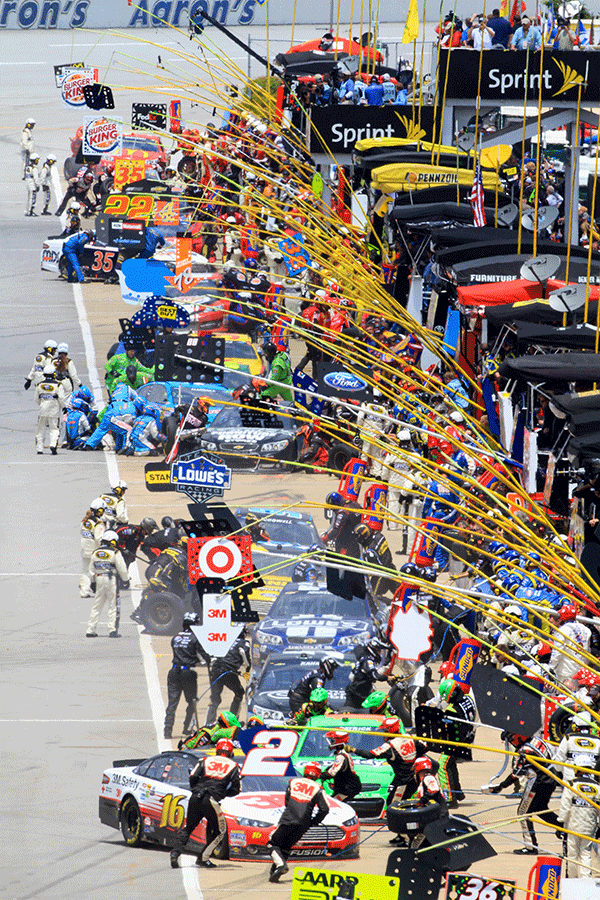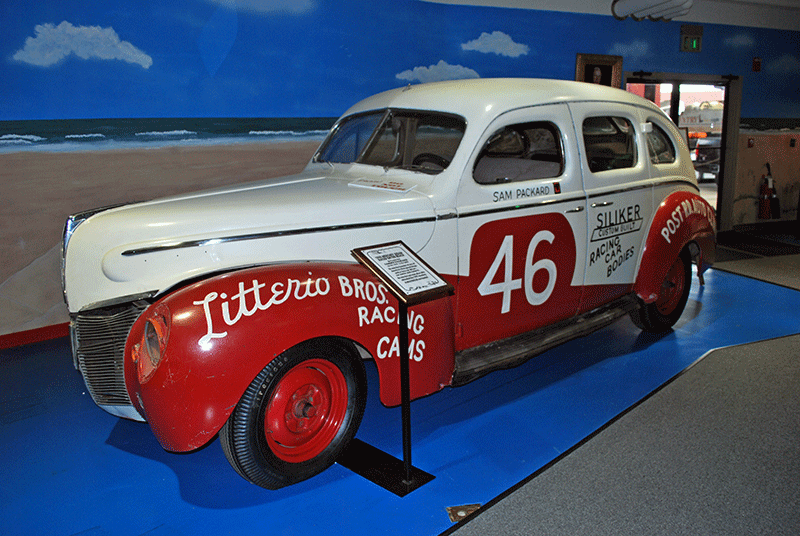By Marilyn Jones

The giant sleeps.
The stands are empty, pit area silent; the 220-acre infield is deserted. The only vehicle on the 2.66-mile track is a minibus filled with tourists wanting to get a closer look at the world of speed, danger and racing legends.
But Talladega Superspeedway will come roaring to life when, for five race days a year, it becomes a force to be reckoned with.
The legend of Talladega includes the men and women who dare face its wide tri-oval track and its 33-degree banking curves. Buddy Baker was the first driver to test at a speed more than 200 mph, with a 200.447 mph lap on March 24, 1970. The late Benny Parsons was the first driver to qualify at more than 200 mph in 1982 with a speed of 200.176 mph.
The superspeedway holds the record for the fastest recorded time by a NASCAR stock car in a closed oval course — 212.809 mph — held by Bill Elliott set in 1987. Rusty Wallace recorded a speed of 216.309 mph, but doesn’t replace the record because it was a radio test and not a NASCAR-sanctioned event.
At these speeds, the giant had become too powerful. In 1987, Bobby Allison’s car went airborne while going through the tri-oval portion of the track. Because of the fear of more cars going airborne, NASCAR imposed a 1988 rule requiring cars running here and at Daytona International Speedway to use carbonator restrictor plates. The plates limit the amount of air and fuel entering the intake manifolds of the engine, greatly reducing the power of the cars and their speed. This change led to a very competitive style of racing at Talladega and Daytona.

Standing at the very top of the grandstands which seats 100,000 race fans, International Motorsports Hall of Fame Operations Manager Bruce Ramey talks about the sheer size of Talladega. “This is a 3,000-acre property,” he says gesturing toward the horizon. “And, the world’s largest campground. We can accommodate 50,000 campers in six campgrounds plus the infield. On race days the energy is unbelievable.”
It was during the 1960s that Bill France decided to build a track that was faster and longer than Daytona. The track, first named Alabama International Motor Speedway, was built on an old airfield and opened September 13, 1969 at a cost of $4 million.
Although drivers were leery of the track, after Richard Brickhouse won the exciting first race, Talladega would go on to host five races a year — three in May, two in October.
“For some people, coming to the races is their annual vacation,” says Ramey. “They camp here; trams transport them from the campgrounds to the track. It’s a family event.”
The tour bus is tiny from this vantage point; like a toy on a child’s racetrack. It slows at a patch of black and white squares; the winner’s circle, Ramey says. And then it starts a lap around the race course. “Of course it can’t get up on those high banks,” he says. “But we can. Want to take a drive?”
“Yes,” I say. The giant may be sleeping, but it is still a thrilling prospect to be able to take a lap or two before the giant wakes again.
Races for October are:
- Oct. 19: Fred’s 250 NASCAR Camping World Truck Series race
- Oct. 20: Camping World RV Sales 500 NASCAR Sprint Cup Series race
Races in May 2014 for the Aaron’s Dream Weekend are:
- ARCA International Motorsports Hall of Fame 250 for the ARCA Series
- Aaron’s 312 NASCAR Nationwide Series race
- Aaron’s 499 NASCAR Sprint Cup Series race
For tickets, call 1-877-Go2-DEGA.
Daily bus tours of Talladega are offered 9:30 a.m. to 4 p.m. every day with the exception of race week, the week following race week, New Year’s Day, Easter, Thanksgiving and Christmas. Tours start from the International Motorsports Hall of Fame adjacent to the superspeedway.
The Talladega complex is located just south of I-20: exit 168 eastbound or exit 173 westbound; follow the signs.
For more information visit www.talladegasuperspeedway.com.
Motorsports Hall of Fame houses racing vehicles, memorabilia

Located next to the Talladega Superspeedway is a racing fan’s paradise, the International Motorsports Hall of Fame.
Earlier this year, four men were inducted into the 2013 Class of the Hall of Fame:
- Dale Inman, best known as Richard Petty’s crew chief for three decades;
- Rusty Wallace, one of NASCAR’s 50 Greatest Drivers with 55 career wins;
- Rick Hendrick, the current owner of the NASCAR team Hendrick Motorsports;
- Don Schumacher, winner of 11 NHRA drag racing championships and 196 event-winning titles.
Since 1990, when 20 of the greatest legends in the world of motorsports were enshrined into the IMHOF, dozens more have been honored by being asked to join this elite group. To visit the Hall of Fame is to honor the men and women who are racers, innovators, financers, designers, engineers and builders; each shaping the world of motorsports on land, water and in the air.
Today, the brick and mortar Hall of Fame is also a motorsport museum spanning three buildings and an enclosed courtyard. The collection of racing vehicles and memorabilia spans from 1902 to the present and includes race cars, a boat, plane and motorcycles. As motorsports history continues to grow, so will the facility.
“Some people take a couple hours to visit the museum,” says IMHOF Operations Manager Bruce Ramey. “And there are diehard fans that spend an entire week here, coming back every day to continue their tour. There is a lot to see.”
In addition to the history-making vehicles, there are display cases with personal effects of motorsports’ greatest achievers; everything from helmets and coveralls to trophies, photographs and news clippings.
For more information call (256) 362-5002 or visit motorsportshalloffame.com.




